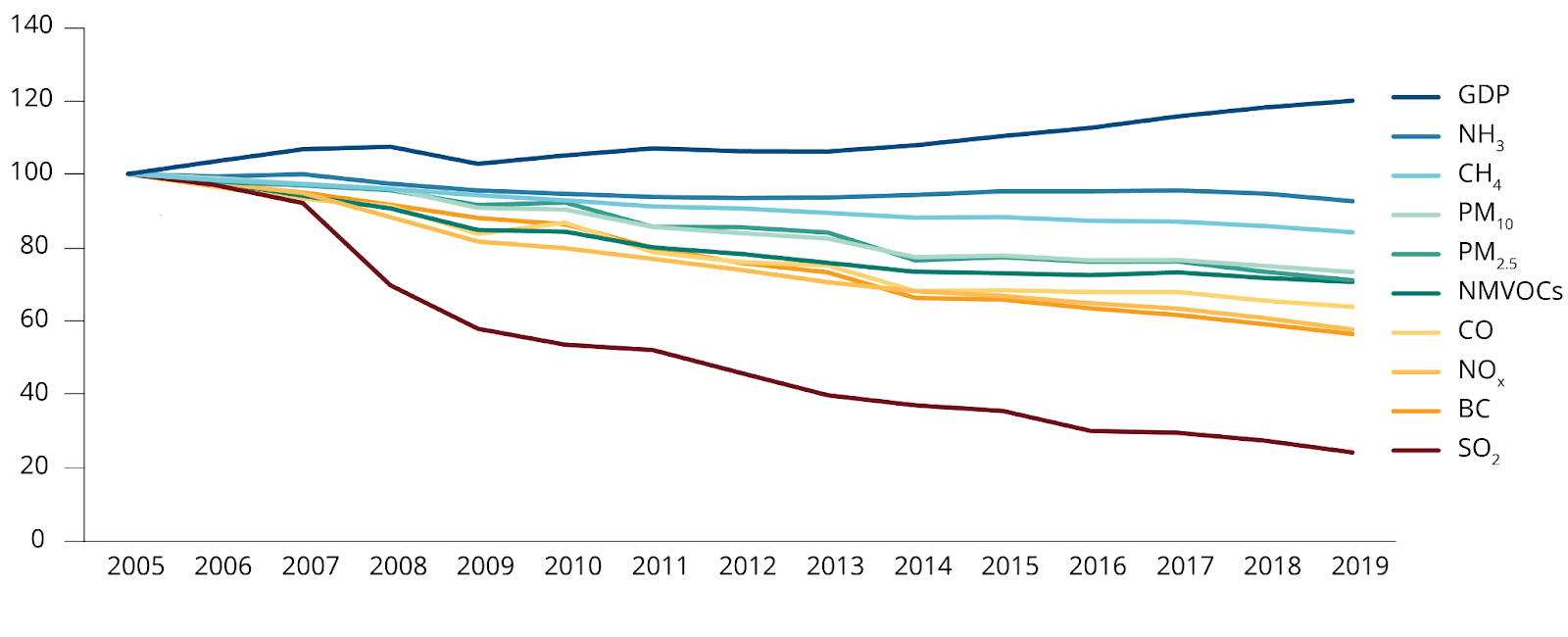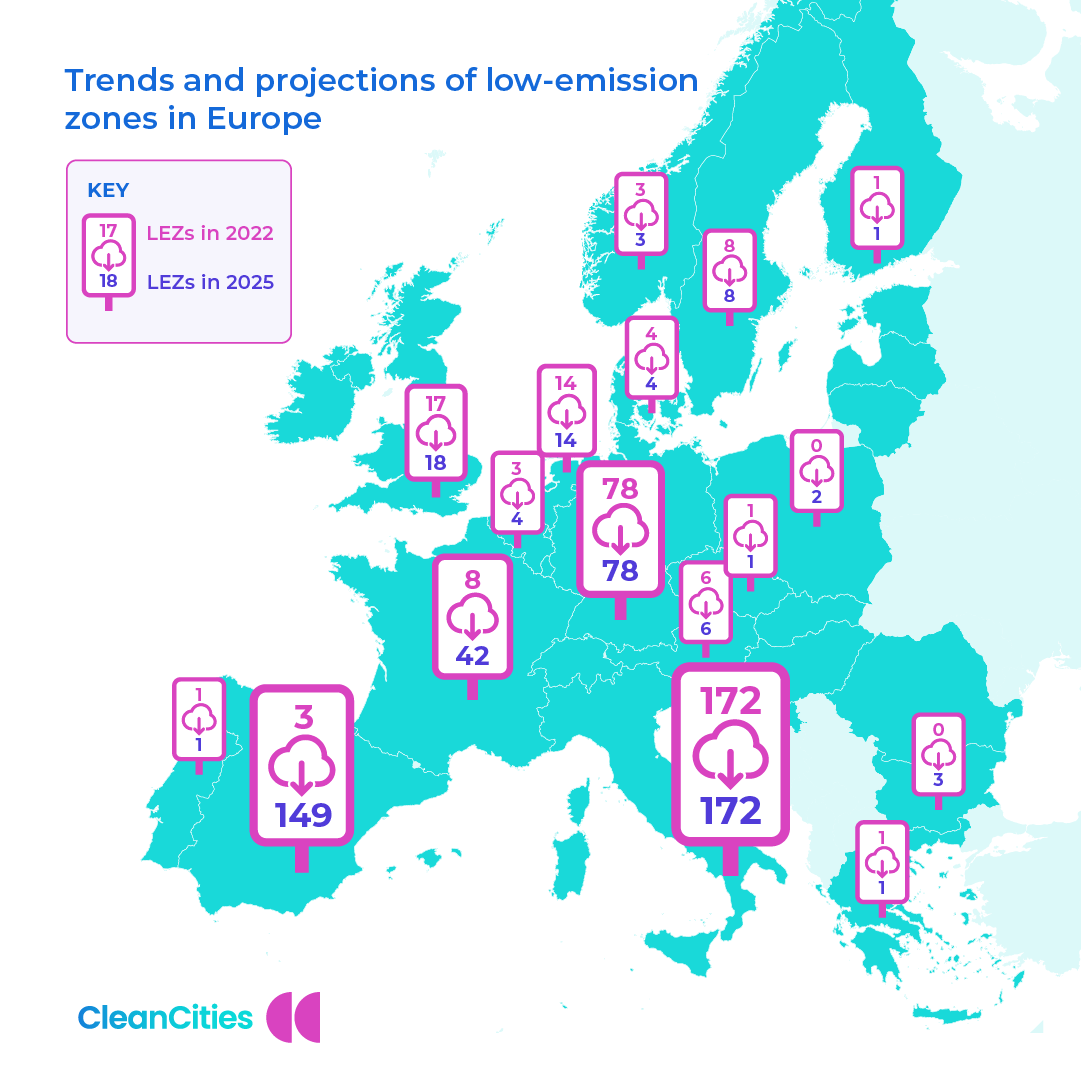Although improving, air pollution remains the biggest environmental threat to human health: a silent killer that causes more than 300,000 premature deaths a year in addition to causing various illnesses such as lung cancer, strokes, asthma, and is suspected to damage every organ in the human body. Transport is a major culprit and specific action is needed to tackle a sector which accounts for almost half of all toxic emissions of Nitrogen Oxides (NOx) in Europe.

Emission trends of main air pollutants, 2005 to 2019. Source: European Environment Agency, 2021
The Ambient Air Quality Directive (AAQD) – with the existing Directive dating back to 2008 – sets concentration limits for certain pollutants that are considered harmful, including Nitrogen Dioxide (NO2) and PM10 and PM2.5 (particles less than 10 µm in diameter and those less than 2.5 µm) – all originating from the combustion of gasoline, oil, diesel fuel – and sets instructions for member states on how to reduce concentrations if the standards are not complied with. Although this legislation has contributed to reducing air pollution compared to 2005, concentrations of air pollution in Europe are still way above what is considered healthy by the World Health Organization (WHO). With 89% of European city dwellers considered to be breathing dangerous levels of NO2, and 96% of them breathing dangerous levels of PM2.5, a revision of the Directive and its pollution limits are long overdue.
The European Commission published its proposal for a revised AAQD in October 2022, which proposes aligning the EU’s standards more closely with the recommendations of the WHO. Overall, it is a step forward towards cleaner air in cities, but there is still much room for improvement and, as it stands, the proposal is a missed opportunity to incentivise tried and tested policies such as low-emission zones and ultimately drive the uptake of zero-emission zones – which only allow zero-emission mobility options such as electrified public transport, freight, private or shared vehicles and active mobility – by 2030.
Firstly, T&E calls on policymakers to align the new Directive with the most recent WHO air quality guidelines. The WHO is the most recognised institution when it comes to air pollution health effects assessment and its 2021 guidelines derive from the most robust health assessment conducted in 15 years. Although the Commission suggests reducing limit values for NO2 from 40µg/m³ to 20µg/m³ and for PM2.5 from 25µg/m³ to 10µg/m³, the proposed limit values would still allow concentrations twice as high as the health-based recommendations of the WHO. Failure to align with the WHO is estimated to amount to 114,000 additional premature deaths a year in European cities.
As it stands, the Commission’s proposal would mainly benefit the last generation of diesel vehicles (Euro 6d), as compliance with the Commission’s proposed new limit values for NO2 would be possible by 2030 under a baseline scenario – i.e. without having to introduce more ambitious changes than the ones currently planned and with the expected uptake of new diesel and petrol cars into the fleet.
Aligning the EU’s new air quality standards with the WHO guidelines, however, is not only cost effective and, according to the European Commission’s own Impact Assessment, would lead to a “significantly positive benefit-to-cost ratio” amounting to net benefits of around €38 billion, but it is also feasible. One of the most effective ways to reduce air pollution in cities is by setting low-emission zones (LEZs) that regulate access to urban areas based on the emissions of motorised vehicles. Still, even ambitious LEZs allow the circulation of harmful petrol and diesel vehicles and should only be a transitional measure towards the introduction of zero-emission zones (ZEZs) that will truly benefit air quality.
LEZs and ZEZs are increasingly common measures (325 cities had an LEZ at the end of 2022 and at least 35 ZEZs are to be set up by 2030) and have been shown to deliver significant air pollution reduction. For example the Ultra-Low Emission Zone in Central London has delivered a 44% reduction in NO2, whilst ZEZs planned in Oxford and Amsterdam are projected to reduce traffic-related nitrogen oxides (NOx) emissions by more than 95%. Despite this, the European Commission failed to model their impact when assessing the feasibility of different targets, including WHO alignment, a serious missed opportunity given all the air quality benefits they offer.

Secondly, Air Quality Plans (AQPs) – a key pillar of the AAQD – should also be strengthened. Timelines for preparing them should be brought forward (in Article 19) and financial penalties put in place to ensure authorities who fail to comply with the limit values are incentivised to act and put in place tried and tested effective measures. To ensure effective measures are included in AQPs, the list of recommended pollution reduction measures should be expanded in Annex VIII Part B, and competent authorities should be required to assess the potential impact of all relevant policies and justify decisions not to implement policies, such as zero-emission zones, that would achieve greater impact. Authorities should also be required to provide evidence that the measures they have selected will achieve at least an equivalent reduction in pollution concentrations.
EU clean air laws have been the main driver for reductions in urban air pollution but cities now need up-to-date and science-based targets from the EU to be able to further implement tried and tested policies that accelerate the uptake of zero emissions mobility and deliver cleaner air. T&E calls on policymakers to ensure the new Directive is aligned with the latest scientific evidence and incentivises authorities to implement ambitious and effective policies that have been shown to reduce emissions from transport. Getting to truly clean and healthy air in cities will require a full and accelerated shift to zero emission mobility.
For more information, download the position paper.


